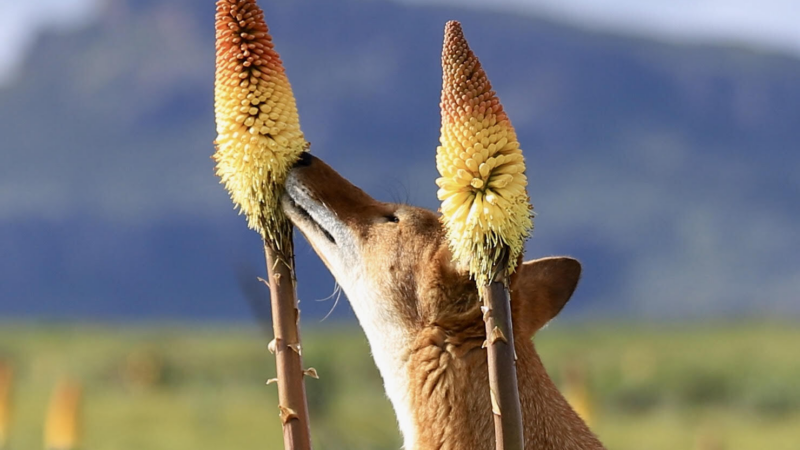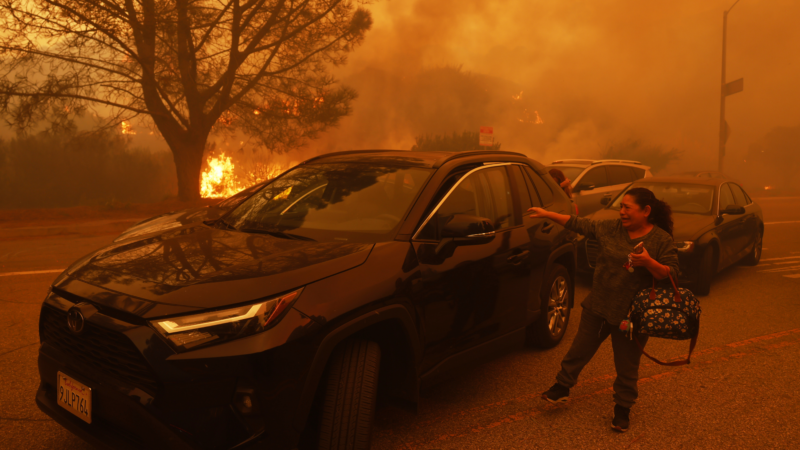A wolf walks into a flower — and appears to pollinate it
The Ethiopian wolf is a reddish-brown solitary hunter only found in the highlands of Ethiopia.
“For now, the population is more or less stable,” says Sandra Lai, senior scientist at the Ethiopian Wolf Conservation Programme and an ecologist at the University of Oxford. “But less than 500 individuals remain.”
Recently, Lai and her colleagues discovered something new about these creatures — the animals occasionally consume the nectar of a plant called the red hot poker.
In other words, the carnivorous Ethiopian wolf may also be a pollinator.
A face full of nectar
Every summer and fall in parts of Ethiopia, the red hot poker blooms, setting the high grasslands ablaze with its clusters of tubular flowers.
“It’s really like fire torches in the landscape,” says Lai. “It is to me sunset colored because it goes from yellow to red. I think it’s very, very beautiful.”
These flowers are loaded with nectar. “You can see children drinking the nectar,” she says. “I tasted it. It’s very sweet. And when you do it, you have pollen all over your face.”
Lai had heard anecdotally that wolves were slurping up nectar from these flowers, and she wanted to see if the rumors were true. Do they go from flower to flower like a busy bee? Her team decided to follow the wolves.
“You really have to go where you have large flower fields,” she says. “You wait for a long time. If you are lucky, a wolf will come.” Lai’s colleague, Adrien Lesaffre, was lucky. Over several days, he spotted and photographed half a dozen wolves feeding on the nectar.
“You do have some individuals that look like they are more attracted to the nectar than others,” she says. “One striking thing was that they could spend a long time—like an hour and a half—foraging on flowers and sometimes visiting up to 20, 30 flowers.”
She says the photographs leave little doubt the wolves love the nectar. In one, a russet-colored animal has its eyes closed as it cranes its head back to lap up the sweet stuff. It almost looks like it’s smiling. In another, an adult and a juvenile forage on nectar together—perhaps, says Lai, an example of how younger wolves learn from older animals.
Finally, in one photo, a wolf looks directly at the camera, its muzzle dusted in pollen. “You see it’s completely yellow,” observes Lai.
This suggests the animal might be transferring pollen from one plant to the next as it feeds, meaning this large carnivore, says Lai, could also be a pollinator.
“We still would need to confirm,” she says. “To have a wolf pollinating flowers is a new thing. I don’t think it was ever reported before.”
A growing cast of pollinating mammals
“It is really exciting,” says Sandy-Lynn Steenhuisen, an ecologist at the University of the Free State in South Africa who wasn’t involved in the research. “Especially for a carnivore to be using these plants as a sugary snack.”
Steenhuisen is curious to know how much energy the wolves are actually obtaining from the nectar. “They’re only going to be flowering for a short period of time,” she says. “They’re not going to sustain these large animals with large energy needs.”
Still, Steenhuisen says the Ethiopian wolves appear to have joined the ranks of a growing list of mammals likely involved in pollination — bats, mice, squirrels, mongooses, honey possums, giraffes, and more. In other words, the system is intricate.
“There’s relationships between plants and animals we didn’t even know about or dream about,” says Steenhuisen.
The researchers in Ethiopia hope the findings will help inform their efforts to conserve the Ethiopian wolf by preventing further habitat loss and raising the animal’s profile
“The fact that it’s found only in one place in Africa,” says Lai, “makes it quite a compelling species to preserve, protect,” as well as to observe and admire.
Her research is published in the journal Ecology.
Photos: Thousands in Los Angeles evacuate as wind-fueled Palisades Fire quickly worsens
More than 30,000 people in Los Angeles County have been ordered to evacuate as the Palisades Fire blazed through the Pacific Palisades community, fueled by intense Santa Ana winds.
Man who exploded Cybertruck in Las Vegas used ChatGPT in planning, police say
The highly decorated soldier who exploded a Tesla Cybertruck outside the Trump hotel in Las Vegas used generative AI including ChatGPT to help plan the attack, Las Vegas police said Tuesday.
Wild weather brings snow to the South and Santa Ana winds to the West
As the South prepped for snow and more cold starting Wednesday, residents in Southern California faced off with hurricane-strength winds.
What to know about Trump and his keen interest in Greenland
President-elect Donald Trump has said multiple times that the U.S. should buy Greenland, an autonomous territory of Denmark. The sparsely populated island is geopolitically important and mineral-rich.
There’s great TV coming in January, from ‘Severance’ Season 2 to a Jerry Springer doc
There is a lot of TV on deck in the new year – including multiple medical dramas, a violent Netflix drama about Utah settlers in the 1850s, plus, cop shows, Westerns and documentaries.
Life-threatening windstorm triggers wildfire in Southern California
Southern California hasn't seen significant rainfall since last April, and a pileup of dry fuel in combination with the winds has the region on edge. A mandatory evacuation order was issued for the Palisades.







